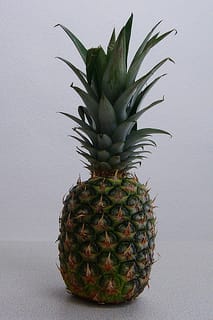Catching up on some reading, I discovered some stories that may be old news to some of you, but merit a second look:
Pineapplegate
 Oh, the pineapple. Photo by Richard North. |
I would like to skip this one, so named for the test question used by a big testing company, Pearson, and subsequently used by a number of states, including New York, for its 8th-grade English language arts exams, that asked kids to analyze a story adapted from one written by popular children’s book author Daniel Pinkwater about a “race” between a hare and a pineapple. Leave it to the intrepid Leonie Haimson, the anti-testing and class size matters pit bull, to uncover this dastardly deed, issue a scathing condemnation that “The ONLY right answer is Pearson; for getting paid $32 million from NY State for these recycled, annoying and pointless exams,” and force the NYS education commissioner to discount the answers on the pineapple test question. The horror of it. Wrote Ms. Haimson a few weeks later, in the New York Times: “…few people who heard about a test question involving a talking pineapple could help but question the judgment of those who would include this material on a standardized test used to determine the future of children and schools.” There is but one reply to Ms. Haimson’s histrionics: “Quoth the raven, `Nevermore.’”
The mind-brain misconnection
The good news is that there’s hope for Ms. Haimson and her followers. Education Week ran a cover story in its June 6 edition titled “Learning is not hard-wired.” As a neurologist manqué (the science and math did me in), I read this story closely, cheering the wonderful optimism embedded in the new research’s conclusion: We can teach kids new tricks long after puberty. “It’s just amazing how flexible the brain is,” says Kurt Fischer, director of the Mind, Brain, and Education Program at Harvard. “That plasticity has been a huge surprise to a whole lot of people.” (Take the test about brain myths, e.g., “Students learn better when the instructional format, such as visual or kinesthetic, matches their natural learning styles.” True or False.) The moral here: Pineapples don’t have sleeves and schools should never give up on kids, regardless of their demographic, familial, and economic backgrounds.
Common Sense awards
In that same issue of Education Week are two stories about wonderfully sensible (I hesitate to use the word any more) reports that come to wonderfully sensible conclusions. First, the one out of Chicago that finds that ELL students’ ninth-grade grades are better predictors of graduation prospects than those students’ language proficiency. Second, mirabula dictu, testing is the best way of learning something. “If you want to concentrate on how to get people to learn durably, you need to concentrate on [testing] as a learning activity,” says Henry Roediger III, director of the Memory Lab at Washington University, which did the report.
Self-pitying tantrums
Kudos to Rick Hess for taking on “the vitriolic, mean-spirited, arrogant, and unreasoning” people who claim to be supporters of public education. Reacting to comments about his column on Scott Walker’s recall election victory, Hess noted that he was greeted by “a slew of scornful, ad hominem attacks.” This has been my own huge disappointment in coming to the education improvement debate: the lack of intellectual decorum on the part of public school promoters. “These are complex questions with lots of room for civil disagreement,” says Hess. “Yet, it seems that the self-proclaimed teacher advocates have shed any hints of civility and any attempt to persuade while rushing to indulge in the kind of self-pitying tantrums most often associated with irate teens. It's a free country, and they're entitled to rant if they wish, but they shouldn't be surprised that they're getting tuned out--or making little headway in the public square.”
Governing the commons
Speaking of intellectual heft, Paul Peterson pens a wonderfully trenchant remembrance of Nobel laureate economist Elinor Ostrum, who, says Peterson, pioneered the notion that
…public services are co-produced by both paid and unpaid labor. Each help the other to do their work effectively, and jointly they produce the service that is needed. The janitor who keeps the schoolhouse immaculate instills in students the sense of responsibility needed to keep hallways clean and washrooms unsoiled. The policeman on the beat, in talks with friends and neighbors, exchanges information necessary to discourage criminal activity.
This too seems like so much common sense, says Peterson, who points out that “its codification has huge public policy implications. After reading Ostrom, one understands why health is not necessarily improved by government-paid health insurance, and students do not learn more simply by experiencing reduced class size.” The essay is short, but it’s must-read. It provides not only a wonderful memorial for a brilliant but low profile academic, but also an entirely refreshing perspective on how we can deliver education to the public, for the public, and with the public.
